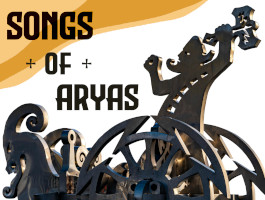Taken from a plebean, juvenile civics coursebook, illustrations not included, only such information required for the casual reader to grasp Muneral plutochratics [0] included.
MUNERIUS!
The Antiquity, History and Function of THE GLADIATOR: His Seven Grades, His 12 Houses, His Christian Duty and His Fraternal Popularity.
Written for the Young Men’s Christian Association or YMCA by Theodore J. Randsom, Profession of Popular Culture and Antiquities, Saint Charles College, New Castle, New Cornwall [1], A.D. 2012
Antiquity
It is true that to the mind of the young Plebe, and nigh even in the minds eye of some scions of high Patrician families, that the heroic spirit of Rome shines in the eyes of youth most brightly upon the reflection of the Gladiator. The glory of the legions of the Seven Caesars is shared with the glory of the 12 Houses of the Sword, for every legionnaire is trained by gladiators and each of the Muneral Orders has gained fame fighting for Christ against Heathen, Saracen and Heretic. Every Roman youth has his favorite House and his favorite gladiator. The glorious aspect of the gladiator is that he is a slave who fights for the freedom of Rome. This man began as the slave of ancient pagan Romans. In Modern Britannic Rome he is a slave to his sworn order, a member of a muneral house for life, each house representing one of Christ’s Apostles, the 12 houses together forming crusading and sustaining orders sworn to await the second coming at the Last Super of Demonry, when Christ returns at their head to banish evil to the Abyss.
…
Antiquity
In 366 B.C., the two sons of a certain Brutus, a patrician laid to rest in his tomb, commanded two pairs of Sammite prisoner of war to consecrate the death of their father in mortal combat before the very tomb door. Under the Republic, a class of enslaved fighting man taken from barbarian tribes and armed after their fashion, would be pitted against one another as a lesson in strife and death. These were traditionally funeral rites called munera, meaning rites due the dead, and would be held most often during the ancient month of Saturn [The entombed pagan god of Time] now the month of Nativity.
A gladiator who survived 5 combats might be manumitted by the editor of the games or even by Caesar in Imperial times. Gladiators were second in celebrity only to chariot drivers and much scandal attended their fetishized status, with senators selling themselves into gladiatorial schools and senatorial wives eloping with hideous old gladiators. The degradation of the institution continued with Comodus, the emperor for whom our toilets are now named, fighting in sham events against gladiators armed with blunt weapons. In A.D. 404, a certain priest entered the arena to stop a gladiatorial combat and was stoned to death by the mob. This caused Christian Rome to outlaw these ancient affairs as an affront to Christ and a holdover from pagan times.
…
History
In A.D. 1529, Augustus Britannicus the 8th, on the eve of the Fall of Vienna, days before news reached London, was visited in dream by the archangel Urial while praying at London Cathedral, and instructed to revive the ancient Gladiatorial schools as crusading orders. The history of each of the 12 Muneral orders will be given in the description of that house.
…
Function
The social function of the Muneral Orders are chiefly the marshaling for a life under arms of able bodied men unqualified for army or naval duty, which is restricted to citizens. Orphans, half-orphans, criminals, prisoners or war and other dispossessed youths or condemned men, upon swearing oaths to Caesar, Augustus and Pope, before The Holy Trinity and taking baptism by bloody brand, become war slaves for life to the house to which they do swear, said house sworn to serve Christ unto the Second Coming.
…
Muneral Duty
-1. To train in traditional and contemporary arms
-2. To instruct soldiers and sailors in contemporary arms
-3. To hunt heretics on behalf of the Church
-4. To battle Saracens and heathens in their realms and in the arena.
-5. To guard the persons of the clergy, especially bishops and Pope, against secular, demonic and heretical threats.
-6. To guard the persons of the Seven Caesars and Augustus against military coups. This has made gladiators and praetorians hereditary enemies.
-7. To combat one another to the death only in order to adjudicate the will of God concerning matters that Church and State authorities disagree.
-8. To serve unto death, and to thence find freedom only upon the heavenly path.
This final clause, based on the ancient and modern funerary fund kept by gladiators to assure Christian burial for their fellows, is the cornerstone of the modern Muneral orders, as fraternities sworn to Christ until death and thence to know salvation.
…
Muneral Popularity
Broadsheets and pamphlets proclaim gladiatorial rites in every major city and most towns across them empire. Most of these pit unrepentant heathen and Saracen captives against popular Gladiators in death matches. However, the most popular events feature rival houses adjudicating disputes between Church and State, as well as between heirs and contrary worded estates, at noon, on Carnival. Carnival is the only day on which two Christians may so duel.
…
Muneral Grades and Significations
A combat may be a duel in the arena, or a military combat, or civic combat in which the gladiator preserved a law or life of an official of the Roman Church or State. Gladiators receive brands for the first 3 ranks, and brands and medals for the 4 upper ranks. Barnds are burned into the right shoulder.
-1. Trainee or Tiro, a youth or new sworn gladiator or, “fresh” or third rate
-2. Deuce, a second rate, who has survived 1 or 2 combats, Instructor of sailors [corporal]
-3. Primo, a first rate, who has survived 3 to 5 combats, Instructor of Soldiers [sergeant]
… The following ranks may employ their medals, worn on the left shoulder of their harness, to brand freshmen in the field, in civic spaces, or on the sands.
-4. Decius, Under Master, 10 to 15 combats, Instructor of Gladiators [master sergeant]
-5. Aptus, Master 16 or more combats, instructor of sergeants [Centurian]
-6. Legate, 40 plus years old, an Aptus who directs a school of a house, for instance, Heraldus, Legate of the New York House Thrax. This person employs House sergeants as military messengers under the authority of the Chaplain.
-7. Chaplain, 40 plus years old, an Aptus who has been ordained as a priest by the bishop of the Great House in London. From among these chaplains the bishop of the order is selected, making of each of the 12 houses, a bishopric, answering directly to the Pope. The Chaplain keeps a shrine of the Holy Trinity under a dome painted with the likeness of the fraternal angel.
…
The Maimed
Those honorable members of a house, who have been disabled may be employed, according to their abilities, as:
-Deacons, those literate gladiators who pass the Chaplain’s examination.
-Trainers, those especially able to offer oral instruct, who serve as judges of practice combats and matchmakers with rival houses.
-Armorers, those inclined to craft, making and maintaining weapons and armor.
-Physicians, those charged with the nutrition and healing of their fellows.
The 12 Houses Munera
Listed here from the most prestigious to least, along with the Month of Favor Sacred to that House…
The Six Crusading Orders
-1st. House Equis, or Knights or Sarmations, August
-2nd. House Gladitorius or Gladiators or Swordsmen, Sepulcher
-3rd. House Myrmillo or Marines, Spring
-4th. House Thrax or Thracian or Highlander or Scots, Winter
-5th. House Retiarius or Boarder or Netman or Catcher, Caesar
-6th. House Prococatuer or Challenger, Easter
The Six Sustaining Orders
-7th. House Secutor or Chaser, Mary
-8th. House Dimacherius or Welshman or Knifeman, Nativity
-9th. House Sagisarius or Archer or Cupidius, Conception
-10th. House Bestiarius or Huntsman, Decline
-11th. House Pugilarius or Boxer, Advent
-12th. House Rudiarius or Stickman or Rodman, Fall
The specific antiquity, history, ongoing glory, and means of induction into such storied orders by pious youths Faithful to the Church, numbered among the Republic of the People, Grateful to the Senate, Committed to the all-sustaining efforts of the Seven Caesars, and LOYAL to Great Augustus, shall be enumerated in the two histories that follow:
-The Six Sustaining Houses Munera
-The Six Crusading Houses Munera
…
Notes
-0. A Munera is a plutocratic fraternity sworn to serve Church and State in the name of The Christ, His Martyrs, that Order’s specified Saint, under the severe governance of God Almighty’s Archangels. [2]
-1. Delaware
-2. The four archangels whom the Britannic Roman Church honors by name are St. Michael, Protector and Defender of the Faithful, St. Gabriel, Messenger of God, St. Raphael, Healer and Uriel Pillar of Divine Strength. The first three are the only three angels who are mentioned by name in Sacred Scripture. Uriel is mentioned in the Visions of Augustus Britannicus the 8th, in A.D. 1529, inspired by the Fall of Vienna and Continental Christendom. The Feast of all four Archangels is September 29.











